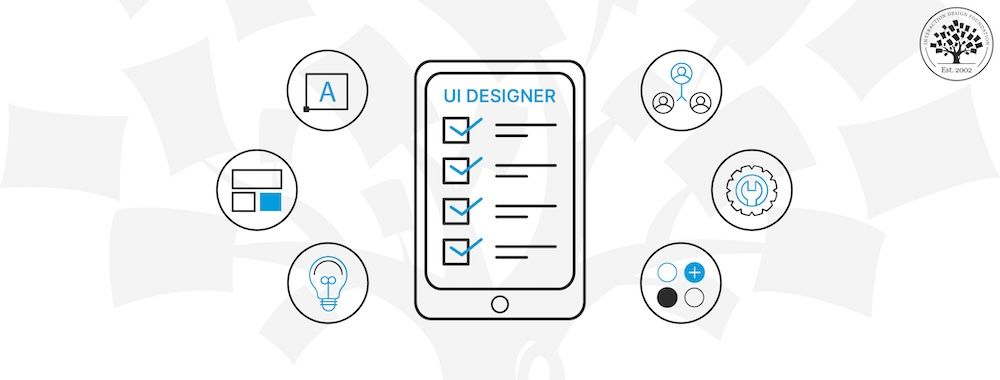What’s in every memorable digital experience is a seamlessly navigable website or an app that feels like second nature—and what lies behind those are user interface (UI) designers; they’re the ones who shape the aesthetics and functionality of any digital interface.
But what does a user interface designer actually do? And why is the skillset they have so in demand? Read on, to find out all about it.
What Is User Interface (UI) Design?
User interface design —or UI design—is the discipline and area about how professionals create visual elements and layouts for a digital product like a website, an app, or a wearable device, but there's much more to it than that and there’s an overall effect that goes one step beyond the screen elements put together in bringing a user—or customer—closer to the brand, every time.
As we mentioned “seamlessly” in our intro to this piece, one aspect of it is how users can forget they’ve got a screen in the way of their experience; UI designers are the ones behind this “magic.” They’re the makers of these “magic” bridges between users and the technology which these designers—along with other project stakeholders—produce. And, when they make users’ digital interactions exceptionally smooth, enjoyable, and efficient, that’s when a brand can score big in the marketplace.
A chief goal UI designers aim for is to create visually appealing designs that have got easy navigation for users.
In this video, Frank Spillers, Service Designer, and Founder and CEO of Experience Dynamics, explains how Google’s Material Design combines beauty and function through clear affordances, visual consistency, and contrast. These are key principles that help UI designers create intuitive, visually engaging interfaces.
Show
Hide
video transcript
- Transcript loading…
Concept of UI Design
What’s the aim of all of this choosing and placing of elements like buttons, icons, typography, negative space, and more? It’s to guide the user through a product like a website while making totally sure that each and every little interaction feels natural and logical to that user—as in, they shouldn’t have to pause to think about something that isn’t clear to them.
UI design isn’t like user experience (UX) design—which focuses on the overall feel and flow of the user's journey—and UI zeroes in on the product's look and interactivity, but, done well, a UI design can go a very long way to making for an ideal UX.
Evolution of UI Design
If we go back to the days of early computers, with their basic, text-based interfaces, we’ll see the best designs for the time appeared on the screens of good brands’ products.
Then, with time, things changed, as advances pushed the constraints of design ever wider, and suddenly those elements that delighted users back in the day could look “blocky” or “clunky” to users who craved immersive and dynamic 3D designs now that they were used to those. And so has gone the progression of UI design, as what is “state of the art” reflects technological advances and changing user needs—just as it’s always done, at least since the second half of the previous century. But it was the explosion of the smartphone onto the scene after the mid-2000s that put things into a kind of “overdrive,” with an unprecedented acceleration of matters, which, by the 2020s has witnessed digital devices getting really ubiquitous; so much so that the demand for intuitive and attractive interfaces has well and truly skyrocketed.
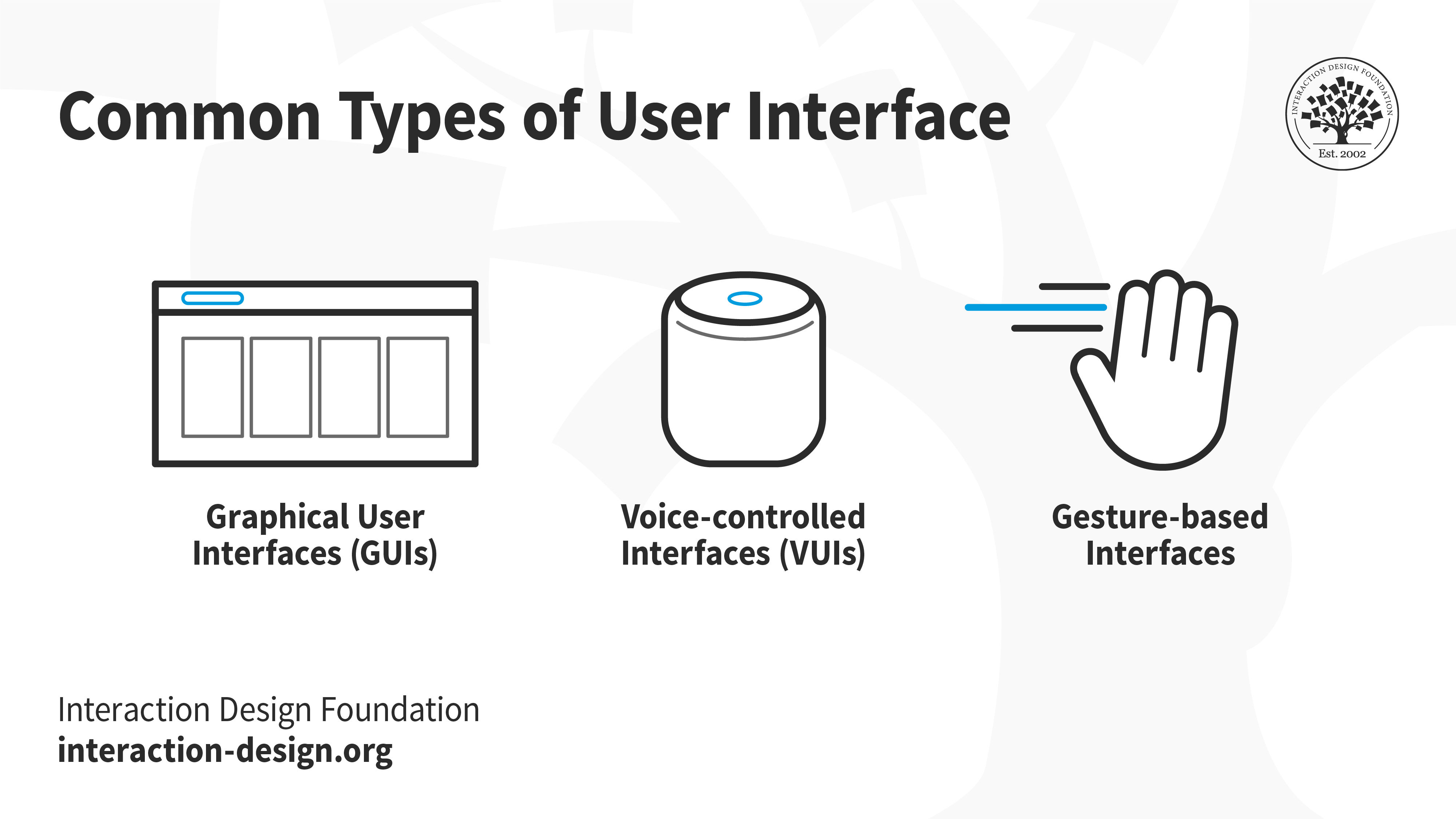
© Interaction Design Foundation, CC BY-SA 4.0
The Significance of UI Design
UI design is one of the most vital deciding factors behind a product's success or failure—and often the interface is the “face” of the brand to the user; so, it’s important to get things right so they trust, enjoy, and—at least, in some contexts where the user may already be rushing about and feeling a little flustered—don’t get frustrated by the UI. Get things wrong in the UI department, and that poor design can push it to the sidelines, and cost a brand dearly.
A great deal of the “magic” of whether users take to a UI is down to how they’ll form perceptions within a few moments of engaging with said interface—we’re talking gut reactions here. That’s why it’s so important to deliver the goods in an instant so you can make that all-important first positive impression. Not for nothing, then, is great UI design about making tehnology that’s captivating, functional, and inclusive, and the influence extends to success in the following areas:
And great UI design is what you practice—and what you can prove through your product—when you create captivating, functional, inclusive, and approachable technology for an exceedingly broad spectrum of users.
Learn how accessibility shapes user experiences. Get a clear perspective on ensuring accessibility for all users.
Show
Hide
video transcript
- Transcript loading…
What It’s Like to Be a User Interface (UI) Designer?
As we’ve seen in the above paragraphs, the world of user interface designers revolves around combining aesthetics with functionality so they make products that pack the most “magic” into seamless experiences for users. What that also means is that all the right elements and interactive properties are there to guide users’ digital experiences so that they’re pleasurable and these users get what they need to get done as efficiently as possible.
If you’re going to be a UI designer working for a brand, you’ll find the job tends to involve understanding the users and the business goals, too—and thoroughly. So, what’s central to the brand’s mission and vision for the users and customers who come to it as the solution they’re looking for? And what’s it really like to be in these users’ shoes, so you get a clear idea of what can help them best?
Get your free template for “UI Checklist.”
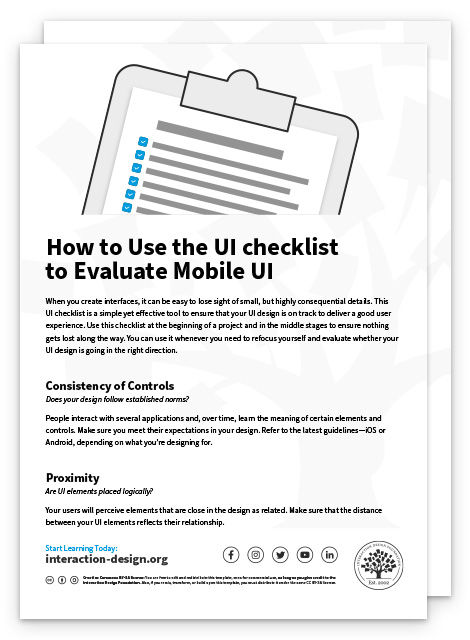

User Interface Designer Responsibilities and Daily Tasks
A user interface (UI) designer gets to wear many hats throughout a (typical) day, and the responsibilities they take on blend creativity, technicality, and collaboration, with pretty much every single task contributing to intuitive, attractive, and functional interfaces—ones that resonate with users and drive business objectives for the brands that delight these users, and customers.
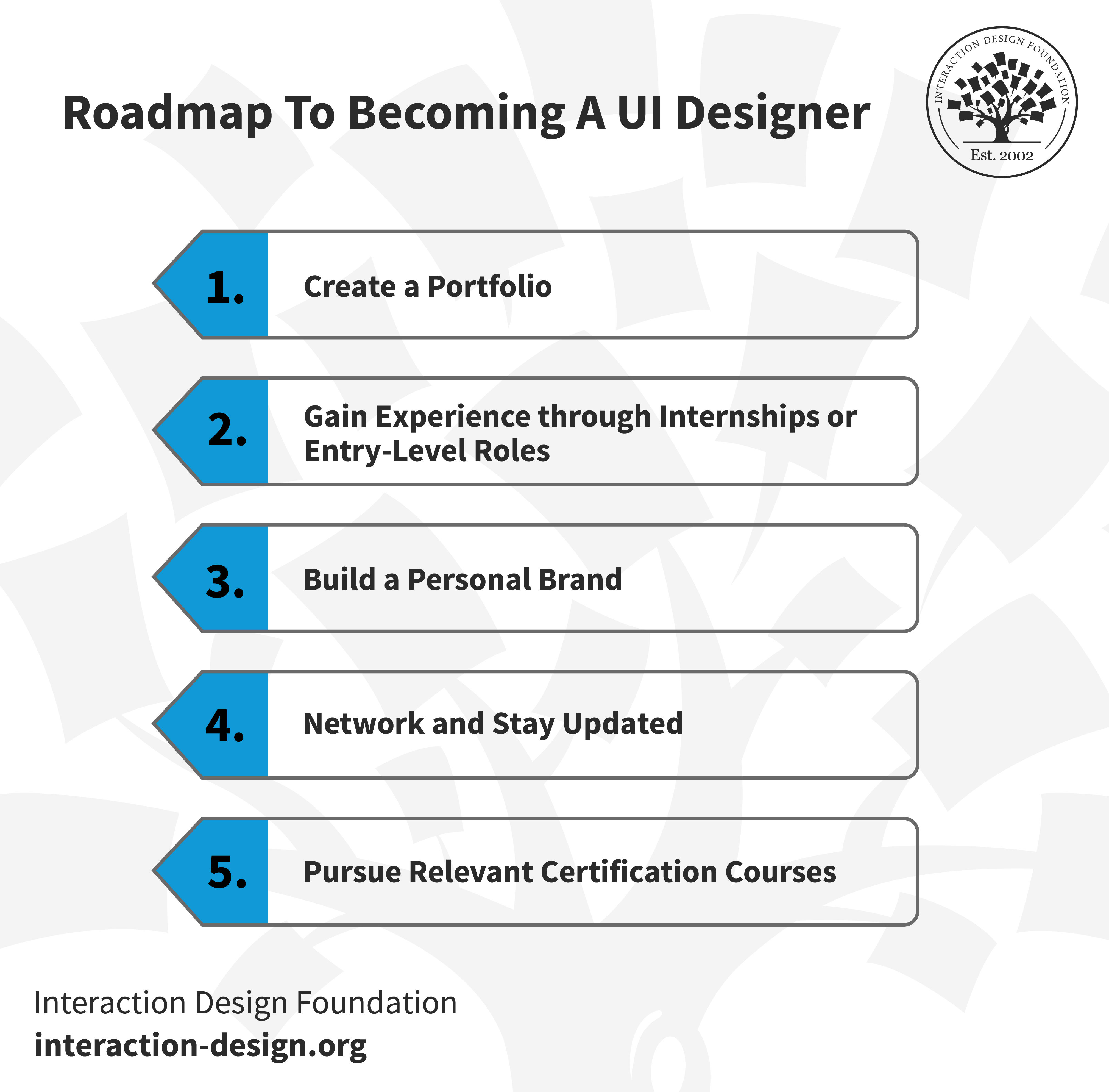
© Interaction Design Foundation, CC BY-SA 4.0
Here are some of the daily responsibilities of a user interface designer, because UI designers have typically got to:
1. Understand Users
Every UI designer has got to review user data and feedback, and it’s something that helps them understand goals, behaviors, and pain points—and the right analysis of this data can bring vital insights that will inform design choices to the point that the interface really will end up meeting user needs. One of the most helpful tools is user or design personas, and they’re a critical part of this understanding.
2. Do Sketching and Wireframing
Before UI designers get into detailed designs, they sketch their ideas to get them down graphically. Then, they create wireframes —and that’s where they’ll build up to a blueprint of the UI tech interface, and it will tend to include a visual representation of the layout, the element placement, and the overall design flow.
3. Do Prototyping
Once wireframes are all ready to go, UI designers create interactive prototypes—valuable deliverables that really act as the working models of the app or webpage. What makes these so valuable, too, is how they let designers test and iterate on their designs, and so they can catch usability issues. Prototypes give stakeholders a tangible sense of what’s going to be the result, and they’re so effective at encouraging feedback collection that the input and insights which designers can come away with can be extremely precious, perhaps even preventing a misstep they might’ve made otherwise.
Watch this video to understand how important prototyping is in the design process.
Show
Hide
video transcript
- Transcript loading…
4. Do Design Iterations
Based on feedback from stakeholders, team members, or user testing, UI designers tweak and improve their designs in an iterative process.
5. Collaborate with UX Designers
To get the best of both worlds, UI designers collaborate with UX designers.
6. Collaborate with Developers
UI designers work with developers to bring their designs to life, too.
7. Stay Updated with Design Trends
UI designers stay informed about tech, trends, and more.
8. Do Documentation
A UI specialist often creates style guides—or design systems that follow guidelines, vital reference points as they outline design principles, color palettes, typography, and UI elements.
9. Stakeholder Presentations
One task that’s recurring and important—and at times can take some careful consideration when the people on the “other side of the table” have no design background—is when designers present designs to stakeholders. UI designers have got to communicate their design rationale, gather feedback in, and make sure that the design well and truly aligns with business goals and brand design guidelines.
10. Usability Testing
While it’s not a daily task, usability testing is an essential responsibility for user interface designers, and that’s because a designer conducts or participates in sessions where real users interact with their designs.
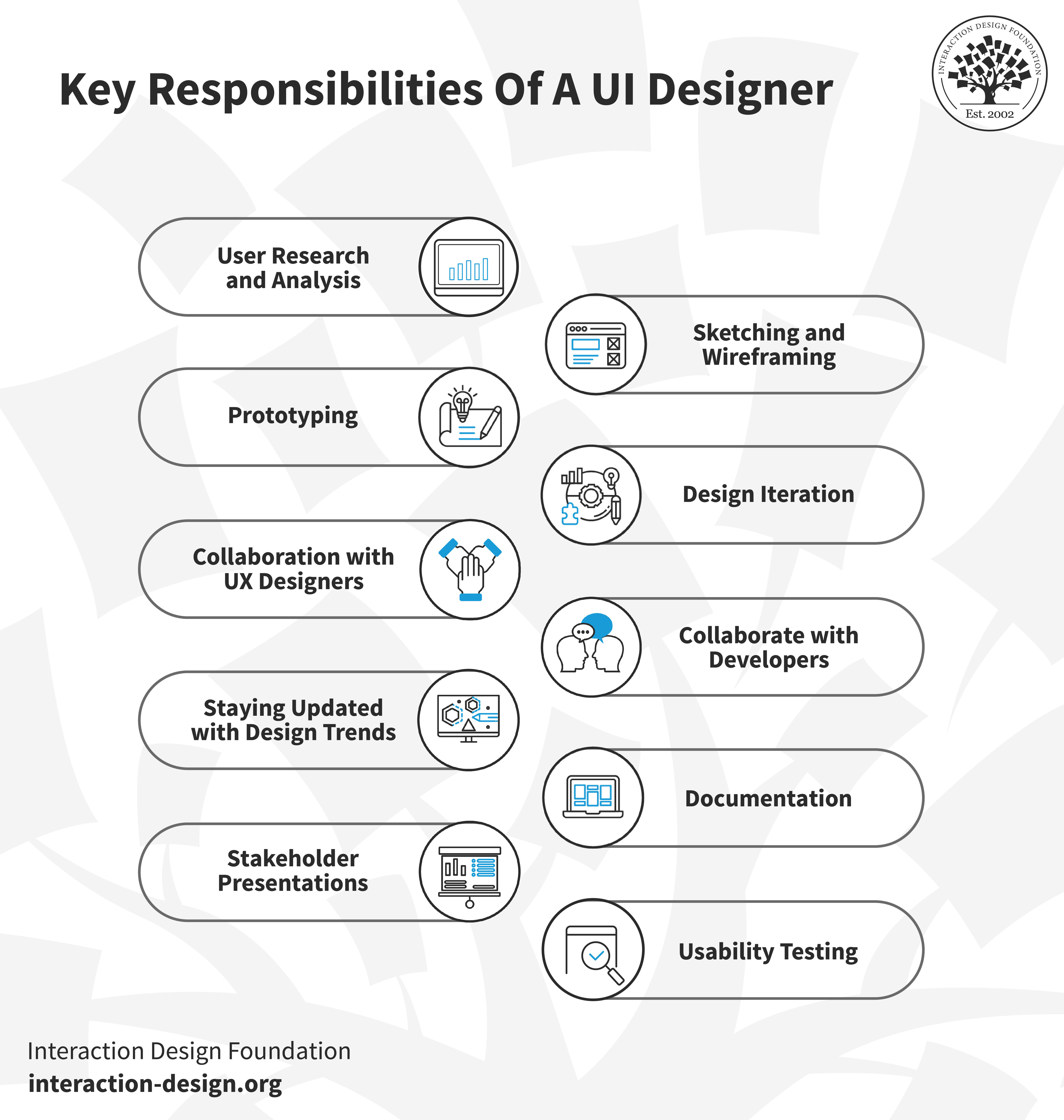
© Interaction Design Foundation, CC BY-SA 4.0
The Road to Becoming a User Interface Designer
Here are a couple of inspiring stories of people who found success in design—read about Vivi Shin, a product designer for a fintech company in Melbourne; and then there’s the story of Dea Minadze, who talks about becoming a self-taught UX/UI designer.
What Are the Skills You Need to Become a User Interface Designer?
Being a UI designer requires a combination of technical and soft skills. Here are essential skills for a UI designer:
Proficiency in design software: You’ve got to understand what programs you should know as the tools of the trade for user interface apps.
Really, it calls for a combination of technical and soft skills to be a UI designer. You may get a degree—and the right one can be a great help—although it’s not strictly necessary; it’s important that you’re familiar with core UI design principles like balance, contrast, consistency, and clarity, and that you’re proficient with the tools of the trade and programs for UI apps and the like. And here are some other important things to have on board:
Responsive design is another thing to be adept at, and your interfaces should give nice and consistent experiences over various device screen sizes.
Have a closer look at crafting versatile digital experiences. Watch this concise guide to responsive design techniques.
Show
Hide
video transcript
- Transcript loading…
Wireframing and prototyping: Vital ways to set out an interface's structure.
User-centered design: Put the users first.
Collaboration skills: It’s a key component of user-centered design.
Typography and color theory: A solid understanding of these is vital, as is the emotional reactions colors invoke.
Attention to detail: For precise design layouts, you’ll have to cater to the minute little details.
Problem-solving: You’ll need to be able to find innovative solutions to design challenges.
Design process: As in, the journey from an idea’s inception all the way through to the final product.
Now, let’s start with the roadmap to becoming a user interface designer.
Step 1: Create a Portfolio
A portfolio is ultra-important—look on it as a kind of passport to take you to the sorts of destinations you’ll want to go as a designer. Maybe more than a passport, it’s like a shop window in that it showcases your skills and versatility as a web user interface designer. But—and this is the big question—how to build a portfolio as a user interface designer?
To start out, work on personal projects or provide freelance services to local businesses.
Put some case studies for select projects, and be sure to talk about the challenges faced, solutions implemented, and the impact your designs actually made on the user experience or business metrics.
Highlight your design process—and that goes from your initial sketches to final prototypes, to show your comprehensive approach to your craft. They’ll—as in, potential clients and employers—want to see the steps on the way to the destination that’s your final product, so they’ll know how you think and handle problems in all their stages. What’s more, it’s important to add interactive visual elements to make what they see dynamic and, of course, to showcase your skills.
Beyond your primary design work, you’ll help yourself a great deal if you work in testimonials and feedback from clients or teammates to your portfolio, as it’ll be something that can lend credibility to your skills and work ethic.
Last—but not least—why not include a section with some learning initiatives in it, things like attending webinars and getting new certifications.
Step 2: Gain Experience through Internships or Entry-Level Roles
Hands-on experience is a superb way to not just get better learning but secure a good job, too, so to work on real-world projects as a gateway to an exciting career that can hit high gear later on, it’s a great idea to go for junior UI design roles or—if you can—internships.
Step 3: Build a Personal Brand
Make sure your brand resonates with your design philosophy and values, and it’s helpful to engage with the design community, share insights on platforms like LinkedIn, and—of course—remain authentic, and the trust and recognition from others will grow.
Step 4: Network and Stay Updated
It’s going to help you a great deal if you join professional organizations, attend conferences, or participate in webinars to get yourself “out there”—not least as it’ll keep you up with the latest UI trends while opening doors for yourself to decent networking opportunities, some of which may be “in the right place at the right time” chances where you’ll find out about that dream position.
Step 5: Pursue Relevant Certification Courses
It mightn’t always be a needed thing, but if you do get a certification from recognized institutions or design courses, it sure can strengthen your credibility and validate your expertise in the field, and put you ahead in the running to get a job you really want—so, this route is also something to bear in mind, perhaps.
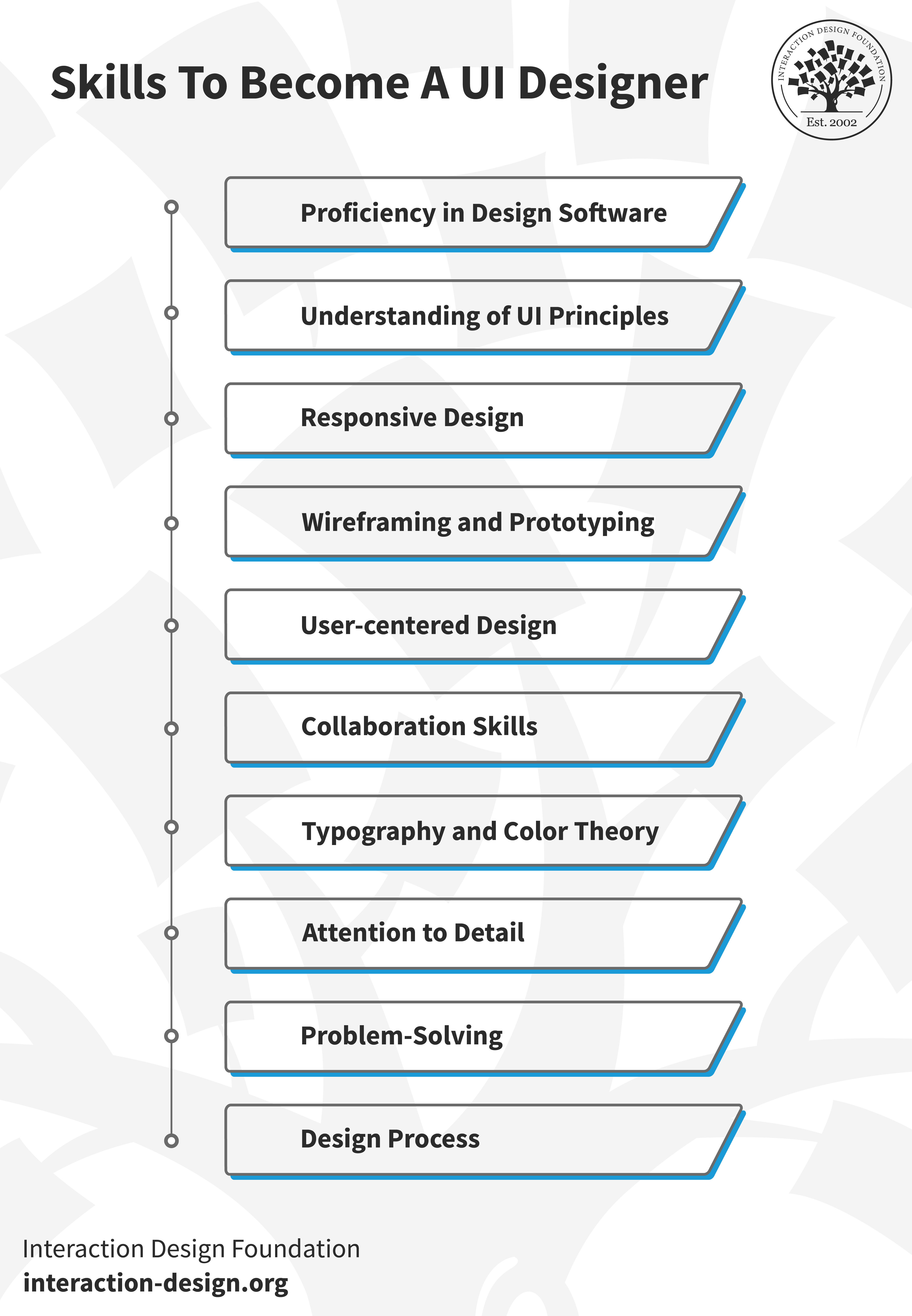
© Interaction Design Foundation, CC BY-SA 4.0
Overall, with growing technologies and exciting new innovations appearing on the horizon, UI designers will be at the forefront, and they’ll be adapting and innovating constantly with their role being an essential one in creating interfaces for new types of devices and experiences, say, for example, in augmented reality (AR) and virtual reality (VR).
